Parishioner Featured: Larry Bethel
Sitting in the same spot every Sunday beneath the crucifix on the north wall you will find a tall intense looking fellow quietly praying at mass. He has an air of seriousness about him, a quiet contemplative sort of energy around him…the aura of a man who loves his faith and practices it seriously. Indeed this man dearly loves the Church but he is far from unapproachable and stodgy….he is Larry Bethel…St. Anthony parishioner and bell ringer (see Post #43, Quasi Modo in the Bell Tower?).
I’ve known Larry only for a short time and mostly from mass, by email and in collaboration on this blog, but I figured Larry to be an intense but private person so I was thrilled when Larry agreed to share his story with all of us.
If I may digress for a moment….When I ask people for an interview I always find that people are quite astonished to learn that anyone might be interested in their “ordinary’ life. But the very opposite is true. I have found that people are very interested in others lives (perhaps because of shared experience and commiseration) and that the most mundane and unglamorous of lives are usually the very opposite…lives full of triumph and hardship, wonderment, amusement, anecdotes, humor and sadness…the profound experiences that great epic novels and lesser telenovelas* are made of.
Larry L. Bethel was bor n in
n in
Larry was not raised in the Church. “…We were not Catholics, we weren't even Protestants. We were golfers. My dad worked 6 days a week from 5 am till whenever. (My grandfather, father and uncle owned dry cleaners). Sunday morning he was golfing and you didn't get in his way. To be honest if I didn't have the Catholic Church I would choose golfing also.”
We are so glad you found
“In about 1973 my brother came home from KU and told my parents he was going to enter the Catholic Church and oh yes, go to
“I went to
“During this trip we went to
“Now fast forward to around 1994 when a couple of things happened. First, my mother, Mary, entered the Church. I have a picture of her first Mass and there beside my beaming mother are two of our former celebrants Fr Jackson and (now) Bishop Conley."
"About the same time I was given a book by some of my brother's friends, This Tremendous Lover by Dom Eugene Boylan. This was the first serious Catholic book I read and it helped me see there was more to the Catholic Church than Galileo, Inquisition, Crusades and the fairy tales made up about them. At the same time I stumbled across the writings of Hilaire Belloc and G. K. Chesterton which I loved (and love) that showed me the "truths" being spouted all over Lawrence (where I lived at that time) were actually age old heresies dressed up in new age clothing.”
Larry then made the choice to enter into RCIA but sadly found that the teacher espoused a “namby pamdy” point of view. “I just needed more teaching with meat on the bone, so that was enough and that was the only time I went.”
Larry moved back to
In 2001 Larry came into the Church and was baptized at age 50. “Oh, happy day!” exclaims Larry. “I started attending St Anthony's Mass and as most remember we only had the Mass on 2nd and 4th Sundays. On other Sundays I would traipse off to Clear Creek or go north to
Larry has held many occupations and avocations including cooking, baking, owner of a bakery, a deli and a restaurant. “We had a good run, but after about 9 years the area of our restaurant was getting run down and after that many years of 12 hour or more days I was getting run down too.”
After that Larry traveled all over
I asked Larry about the Traditional Latin Mass (EFLR). “I, of course love the old Latin Mass and am thrilled to be able to attend every Sunday. It did take me a while to catch on to what is happening at the Traditional Mass and I am still catching on. It's the beauty of the whole thing that hits me…the beautiful poetry of the liturgy, the music lifting our hearts and the form and colors of our beautiful St Anthony Church. But most of all I love the quiet stillness of the consecration as we worship our Lord.”
*telenovela: Latin American soap opera
Learning About the Mass Liturgical Vessels
Pictures and descriptions courtesy of
http://www.fisheaters.com
I find these sacred vessels fascinating in the fact that these are actual material things that are touched by God or have been assigned such value by Mother Church as to render them sacred and (some vessels) untouchable by the common man.
These vessels all have special meaning and value to the Church, the liturgy and all Catholics, with specific rules of use and decorum.
The following is from the good folk at Fisheaters, http://www.fisheaters.com and is short enough to be interesting without being laborious. Another good web page for explanation of sacred vessels is http://www.newadvent.org/cathen/01357e.htm which is the New Advent website.
___________________________________________________
A. Chalice Veil which covers the Chalice underneath B: Burse
C: Cross on front of veil. D: Corporal on which the veiled Chalice sits.
E: Chalice F: Paten
G: Purificator H: Corporal
I: Ciborium J: Folded Chalice Veil
K: Pall L: Burse
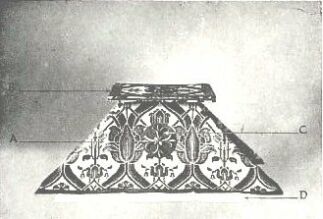
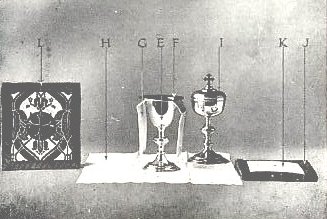 | |||||
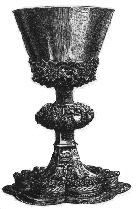 | Chalice The consecrated gold or gilded silver cup used to hold the Precious Blood. Only priests or deacons are allowed to touch the Chalice (though sacristans may in the course of their duties). Pewter Chalices are "okay" for use during times of persecution but, even then, the inside of the bowl must be gilded. When Mass begins, the Chalice is covered by the folded purificator and the pall (see below). | |
| Paten The consecrated gold or gilded silver plate on which the Sacred Host is laid. Only priests or deacons are allowed to touch the Paten (though sacristans may in the course of their duties). A Communion Paten has a handle and is held under the chin of one receiving the Eucharist so that in case the Host is dropped, it won't fall to the floor. | |
| Ciborium A chalice-shaped vessel with a lid used to hold consecrated Hosts for distribution during the Communion of the faithful. It can be made of any material as long as the inside is gilded. It is kept in the Tabernacle between Masses, covered with a white veil (which can be decorated with precious metals). | |
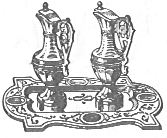 | Cruets These vessels hold the water and wine before Consecration | |
| Monstrance (or "Ostensorium" or "Ostensory") A gold or silver vessel, often in a sunburst shape, with a clear glass area, called a "luna," for viewing the Sacrament. The Host is kept in place inside the crystal or glass frame by a crescent shaped gold or silver gilded clip called a "lunette." The monstrance is used during Benedictions and processions, etc., for adoration by the faithful. It doesn't require a blessing, but it should be blessed. | |
 | Aspersory and Aspergillum (or "Aspergill") The Aspersory is a container for holding Holy Water. The Aspergillum is a stick-shaped implement with holes in it to dip into the Aspersory and catch the Holy Water for sprinkling the people and things. Because of Leviticus 14:49-52, Numbers 19:18, Psalm 50:9, etc., the aspergillum used to contain crushed Biblical hyssop (Origanum syriacum) to catch the water, but nowadays a small sponge is more often used. | |
| Thurible (or "Censer") and Boat A thurible is the incense burner used at Mass. It hangs from chains so it can be swung to incense people and things. The boat is where the incense is stored until it is placed in the thurible. | |
| Pyx
| |
Altar Linens | ||
| Chalice veil Small silk cloth, of the same color as the priest's vestments, used to cover the Chalice | ||
| Purificator (or "Mundatory" or "Purificatory") Rectangular piece of linen or hemp used to wipe the Chalice before the Offertory and after Communion, the priest's lips and fingers. It requres no special blessing. | ||
| Pall A blessed, stiff square piece of linen, sometimes decorated with a Cross or other embroidery, used to cover the Chalice to prevent impurities from falling into it. If it is embroidered or made of silk, the side touching the Chalice must still be made of linen. Another type of pall is the cloth used to cover coffins at Requiem Masses. | ||
| Finger Towels These may be made of any material (preferably linen) and are used at the lavabo and after Communion | ||
| Corporal A blessed square linen cloth which is spread out by the priest in the middle of the Altar. From the Catholic Encylopedia, "after it [the corporal] is washed, bleached, and ironed, it is folded into three equal parts, both in its length and in its width, i.e. the anterior part is folded over the middle; then the posterior part is turned down over the anterior part; after this the part at the priest's right is folded over the middle, and finally the part at the priest's left is folded over these. The corporal is placed in the burse in such a manner that the edge of the last fold is towards the opening of the burse." | ||
Burse |
One of These Things Just Doesn't Belong
One of these things just doesn't belong,
Can you tell which thing is not like the others
By the time I finish my song?


Summorum Pontificum One Year Later
An Interview with Fr. John Berg, Superior General of the Priestly Fraternity of St. Peter
http://www.remnantnewspaper.com/Archives/archive-2008-summorum_pontificum_one_year_lat.htm
Brian Mershon
THE REMNANT COLUMNIST, Texas
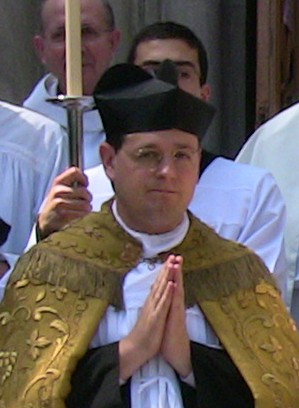
Fr. Berg outlines the current growth in apostolates for the F SSP both in the U.S. and worldwide, along with his impressions of the deeper significance behind the recent ordinations by high-ranking members of the Roman curia.
He also provides an update on the FSSP’s role in assisting with the education of diocesan and religious priests wishing to learn the Traditional Roman rite. In addition, Fr. Berg touches on some controversial issues regarding concelebration and the “cross-pollination” of the two forms of the Roman rite.
Continued at original article...(click here)
The Transformation of the Jewish Liturgy into the Eucharistic Sacrifice of the New Law
With extracts from How Christ Said the First Mass by Fr. James L. Meagher, 1984 TAN reprint and the Catechism of the Council of Trent.
Our Lord Jesus Christ, the High-priest of the New covenant, instituted the Eucharistic Sacrifice of the New Law at the Last Supper; this is an indisputable doctrine of the holy Catholic Church. Moreover, our Lord Jesus transformed the ancient Jewish Temple liturgy, and the Passover, familiar to His twelve apostles and their successors, into the Eucharistic Sacrifice of the New Law. This author uses the proper noun Eucharistic Sacrifice of the New Law as opposed to Roman-rite of the Mass because the Eastern Catholic Churches employ different terms for the one, same perpetual Eucharistic Sacrifice; for example, Byzantine Liturgy, Divine Liturgy, or Eucharistic Liturgy.
Our Lord, the Apostles, and His disciples frequently participated in the
In the middle of the Holy of Holies is a golden alter, a prototype of Jesus Christ, which was incensed by the Jewish priest just like Catholic priests incense the alter before or during the Eucharistic Sacrifice. Remarkably, Eastern Catholic Churches’ arrange their sanctuaries like the gold alter of incense inside the Holy of Holies. Also placed in the Holies is a large candleholder, called candelabrum, with 7 lamps signifying both the 7 gifts of the Holy Ghost and the seven sacraments.
This concludes the first installment of how our Lord transformed the Hebrew Liturgy into the Eucharistic Sacrifice of the New Law.
The Story of Two Monks
Two monks were making a pilgrimage to venerate the relics of a great Saint. During the course of their journey, they came to a river where they met a beautiful young woman -- an apparently worldly creature, dressed in expensive finery and with her hair done up in the latest fashion. She was afraid of the current and afraid of ruining her lovely clothing, so asked the brothers if they might carry her across the river.
The younger and more exacting of the brothers was offended at the very idea and turned away with an attitude of disgust. The older brother didn't hesitate, and quickly picked the woman up on his shoulders, carried her across the river, and set her down on the other side. She thanked him and went on her way, and the brother waded back through the waters.
The monks resumed their walk, the older one in perfect equanimity and enjoying the beautiful countryside, while the younger one grew more and more brooding and distracted, so much so that he could keep his silence no longer and suddenly burst out, "Brother, we are taught to avoid contact with women, and there you were, not just touching a woman, but carrying her on your shoulders!"
The older monk looked at the younger with a loving, pitiful smile and said, "Brother, I set her down on the other side of the river; are you still carrying her?"






No comments:
Post a Comment